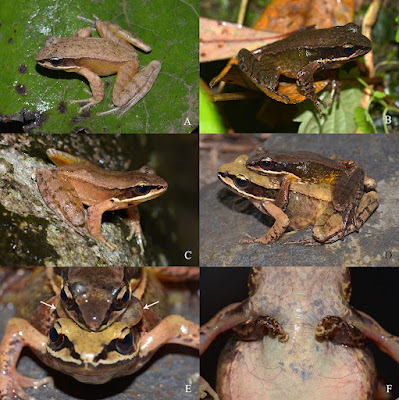 |
| Hemiplecta ligorica & H. thailandica Sutcharit & Panha, in Sutcharit, Jeratthitikul, Tongkerd & Panha, 2021. |
Abstract
Indochina land snails of the family Ariophantidae are in need of thorough systematic revision. Here we comprehensively revise the systematics of the large-shelled, sinistral (counterclockwise) coiling snails from Thailand and Peninsular Malaysia. Molecular phylogeny based on mitochondrial (coi and 16S) and nuclear (28S) gene sequences demonstrates that these sinistral snails are not members of Dyakiidae as previously thought, but instead are more closely related to the genus Hemiplecta in the family Ariophantidae. Comparative morphology also reveals similarity of reproductive organ features (globular gametolytic organ, well-developed dart apparatus, and lack of amatorial organ complex). Based on this evidence, we propose to transfer these sinistral snails to the genus Hemiplecta. Molecular phylogenetic analyses further strongly support the monophyly of this sinistral lineage with respect to other members of Hemiplecta. This monophyletic clade consists of five members including three species that were previously classified as “Dyakia”, H. lahatensis, H. retrorsa and H. salangana, and two new species described herein, Hemiplecta ligorica n. sp. and H. thailandica n. sp. This study also suggests that the anatomy of the gametolytic organ in the genus Hemiplecta corresponds well with the phylogenetic relationships and appears to be a taxonomically informative character, while the penial verge has little utility for generic recognition.
Keywords: Pulmonata; Dyakiidae; sinistral; endemic species; Indochina
Family Ariophantidae Godwin-Austen, 1888
Genus Hemiplecta Albers, 1850
1. Hemiplecta retrorsa (Gould, 1843)
2. Hemiplecta salangana (Martens, 1883)
3. Hemiplecta lahatensis (Morgan, 1885)
4. Hemiplecta thailandica Sutcharit and Panha, n. sp.
Etymology. The species name “thailandica” refers to the type locality of this new species in Chanthaburi Province, Thailand.
Diagnosis. Large and low conic shell with brown to brownish yellow shell color, rounded last whorl with narrow dark brown spiral band on periphery. Penial sculpture with small penial papillae arranged over nearly entire penis length.
5. Hemiplecta ligorica Sutcharit and Panha, n. sp.
Etymology. For the historical name of Nakhon Si Thammarat Province, where the type locality is situated.
Diagnosis. Small, sinistral helicoild shell with whitish color, rounded last whorl with dark brown to brownish spiral band on periphery and upper shell surface. Penial sculpture with small papillae arranged over about half of penis length.
Conclusion:
Based on phylogenetic results and morphological information in the present study, we have transferred the sinistral species previously and incorrectly assigned to Dyakia (family Dyakiidae) to the genus Hemiplecta (family Ariophantidae). Two previously unrecognised species are described based on consistent differentiation in molecular, shell, and genitalia characters. Our data also provide further support for three other sinistral Hemiplecta species, which are also re-described herein. The results also suggest the synonymization of the formerly recognized as (sub)genus Koratia under the Hemiplecta. Finally, the results indicate the evolutionary instability of shell traits that are often used for land snail classification, while genital characters are highlighted as reliable taxonomic markers for delimiting species and at least some higher taxa. The integration of multiple independent characters including molecular evidence is crucial for delimiting higher systematic levels.
Chirasak Sutcharit, Ekgachai Jeratthitikul, Piyoros Tongkerd and Somsak Panha. 2021. Reassessment and Systematic Position of the Sinistral Snails of Genus Hemiplecta from Thailand (Eupulmonata: Ariophantidae), with Description of Two New Species. Contributions to Zoology. 90(2); 183–215.



















































